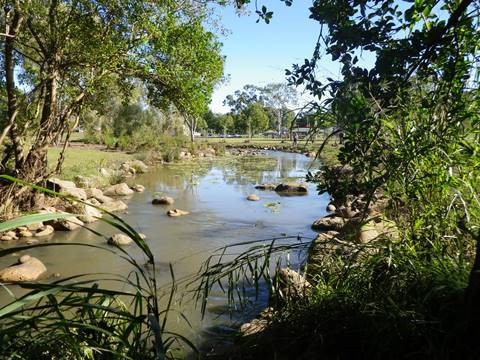|
|
Bypass fishwayBypass fishway – Key considerations Select from the tabs below In addition to the general information for all fishway types, the following applies to bypass fishways. Requirements for effective passageA low gradient is essential for functional bypass fishways. These fishways are popular in Europe, where they have, in some instances, replaced pool-type fishways. European waterways generally have more flow, which is also a requirement for optimal functionality of bypass fishways[3]. Suitability and limitationsThe low gradient requires a larger footprint than most other designs, however, this also means there is more flexibility to design for a broad size range of fish and other aquatic fauna including turtles and invertebrates[1]. A bypass fishway in Weipa is reported to be successfully passing a broad range of species and sizes (Andrew Berghuis pers. comm.). Bypass fishway designs are highly variable. They may include a high degree of bottom roughness using rocks, and often have areas of rapidly moving water, both of which make sampling a challenge. The methods required to assess the hydraulic conditions of a bypass fishway will be specific to the type of flow control structure (e.g. cone and/or rock ramp). These designs can be expensive,[2] depending on design and location, but bypass fishways can be a cheaper alternative to more technical fishways[4]. Where the fishway is constructed of rock, as opposed to an earthen channel design, a rock supply is required relatively close to site as this is a major cost consideration. Bypass fishways do not accommodate highly variable headwater levels and may require relatively consistent and high discharge, which both tend to be limiting the broad application of bypass fishways in Australia[3][1]. This type of fishway has a reasonably high degree of redundancy (e.g. if partly blocked by debris other parts of the fishway will still function), however like all fishways does require regular maintenance. Disclaimer: In addition to the standard disclaimer located at the bottom of the page, please note the Fishways (biopassage structures) disclaimer. References
Last updated: 10 May 2021 This page should be cited as: Department of the Environment, Tourism, Science and Innovation, Queensland (2021) Bypass fishway – Key considerations , WetlandInfo website, accessed 15 December 2025. Available at: https://wetlandinfo.detsi.qld.gov.au/wetlands/management/fish-passage/technologies/fishway-options/bypass/key-considerations.html |

 — Department of the Environment, Tourism, Science and Innovation
— Department of the Environment, Tourism, Science and Innovation

